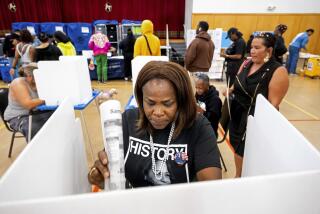A president by popular vote
- Share via
The last time the electoral college received much attention was in 2000, when Al Gore won the popular vote for president while being denied victory over George W. Bush because of a second-place finish in electoral votes. Reformers hoped that discrepancy would be the impetus for approval of a constitutional amendment establishing what many Americans believed already existed: a nationwide popular vote for president. But the moment passed.
Now a legislator in Pennsylvania is proposing a change in that state’s election law that would bring the presidential vote there closer to the one-person, one-vote principle that is at the heart of a popular vote. Senate Majority Leader Dominic Pileggi is proposing that Pennsylvania’s electoral votes no longer be awarded on a statewide, winner-take-all basis. Instead, they would be divided proportionally depending on who won in each of the state’s congressional districts, making them more reflective of the popular vote in the state. The remaining two votes would go to the statewide winner.
Opposition to this plan has come largely from Democrats, who worry that district-by-district apportionment of electoral votes in Pennsylvania would favor a Republican nominee. That is hardly a principled objection. But other critics object to a situation in which Pennsylvania would opt out of the system used by virtually every other state. (Only two states, Nebraska and Maine, apportion electoral votes partly by congressional district.)
An alternative, and preferable, reform was signed into California law this summer by Gov. Jerry Brown. It commits California to awarding its electoral votes for president to the winner of the national popular vote. The provision, however, takes effect only when states with a total of 270 votes or more — the winning margin in the electoral college — sign on to the system. It’s an ingenious approach that would turn the presidential election into a popular vote without a constitutional amendment. (In addition to making the presidential election more democratic, it would also encourage candidates to campaign in formerly “safe” states.)
Of course, neither of these arrangements is a substitute for the abolition of the electoral college through a constitutional amendment. The system is a vestige of a time when states’ rights were considered more important than individual rights. If voters can directly elect senators, as they have done since ratification of the 17th Amendment in 1913, they should be able to vote directly for president.
Presidents do not have any role in the enactment of constitutional amendments. Still, candidates for the office in 2012 should be asked whether they support abolishing the electoral college or taking other measures to ensure that presidents are elected by a majority vote. Their answers would demonstrate just how democratic they think this republic should be.
More to Read
A cure for the common opinion
Get thought-provoking perspectives with our weekly newsletter.
You may occasionally receive promotional content from the Los Angeles Times.






